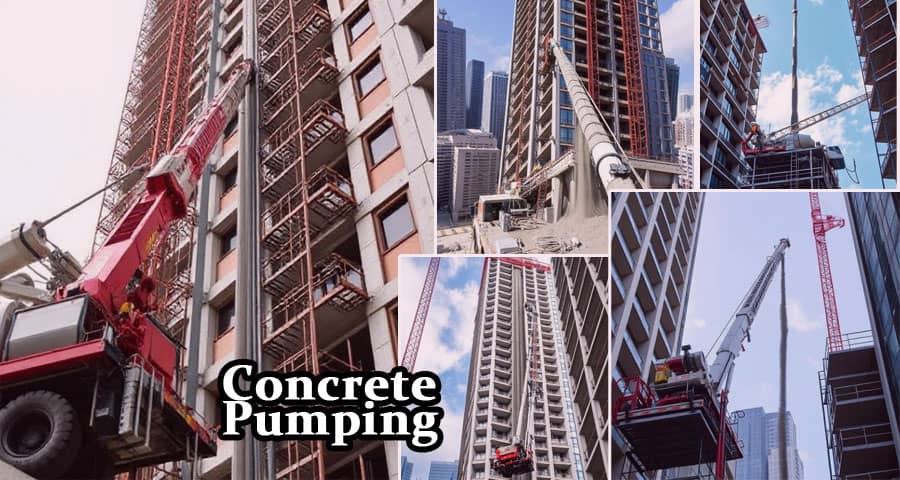How do you pump the concrete to the top floor in a high-rise building?

Concrete pumping is a crucial process in the construction of high-rise buildings. With the advancements in construction technology, the method of transporting concrete vertically has become more efficient and reliable.
Understanding Concrete Pumping
Concrete pumping is the process of transporting freshly mixed concrete from the ground to elevated locations using specialized equipment. This method eliminates the need for excessive manual labor, ensuring faster and more accurate concrete placement.
There are two primary types of concrete pumps:
- Boom Pumps: Equipped with a hydraulic arm, boom pumps can reach high elevations and are commonly used for large-scale construction projects.
- Line Pumps: These pumps use flexible hoses and are ideal for projects with limited access or smaller concrete placements.
Choosing the Right Pump for High-Rise Construction
When it comes to pumping concrete to the top floors of a high-rise building, selecting the appropriate pump is essential. Several factors influence the choice of pump, including:
- Height of the Building: Boom pumps are generally preferred for heights up to 50 meters, while specialized high-pressure pumps are used for taller structures.
- Concrete Mix Design: A well-designed concrete mix with the right consistency ensures smooth pumping without blockages.
- Pump Capacity: The pump's output rate, measured in cubic meters per hour, should meet the project's requirements.
Key Equipment for Concrete Pumping
- Concrete Boom Pumps: With extended arms that can reach up to 70 meters or more, these pumps are commonly used for high-rise buildings.
- High-Pressure Pumps: For skyscrapers and tall structures, specialized pumps with enhanced pressure capacities are essential.
- Pipelines and Hoses: Steel and rubber pipelines are used to transport concrete from the pump to the designated location.
- Concrete Batching Plant: A consistent supply of fresh concrete is maintained through batching plants.
Concrete Pumping Process for High-Rise Buildings
1. Setting Up the Pump
The pump is strategically positioned on the ground, ensuring stability and easy access to the concrete supply. For taller buildings, vertical pipelines are connected from the pump to the desired height.
2. Concrete Placement
The concrete is poured into the pump hopper, where it is pressurized and pushed through the pipelines. High-pressure concrete pumps are capable of pumping concrete to heights exceeding 300 meters.
3. Maintaining Flow and Quality
To ensure consistent flow and avoid blockages, proper lubrication using pumping aids or water is applied to the pipelines. Monitoring the pressure and adjusting the pump speed is crucial for maintaining the desired flow rate.
4. Safety Measures During Pumping
Safety is paramount in high-rise construction. Operators follow strict guidelines to prevent accidents, including:
- Securing pipelines to avoid sudden movement.
- Conducting regular inspections for leaks and blockages.
- Using protective barriers around the pumping area.
Challenges in Pumping Concrete to the Top Floor
- Pressure Management: As the height increases, greater pressure is required to pump the concrete. Specialized high-pressure pumps are designed to withstand these demands.
- Concrete Segregation: Improper mix design can lead to separation of aggregates and cement slurry during pumping.
- Pipeline Blockages: Regular pipeline cleaning and proper concrete mix design minimize blockages.
Best Practices for Efficient Concrete Pumping
- Use Proper Concrete Mix: Ensure the mix has adequate workability and is pumpable without segregation.
- Optimize Pump Selection: Choose a pump with the appropriate pressure capacity and reach.
- Conduct Regular Maintenance: Frequent checks and cleaning of the pump and pipelines prevent downtime.
- Coordinate with Teams: Seamless communication between the pump operator, concrete supplier, and construction team ensures timely progress.
Conclusion
Pumping concrete to the top floors of high-rise buildings is a sophisticated yet highly efficient method in modern construction. By utilizing the right equipment, maintaining safety standards, and following best practices, construction companies can achieve timely project completion with minimal disruptions.
Please watch the following short video for Concrete Pumping
